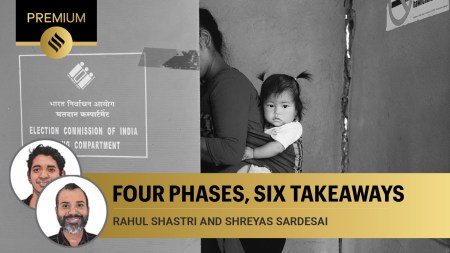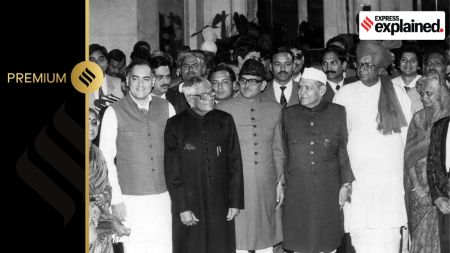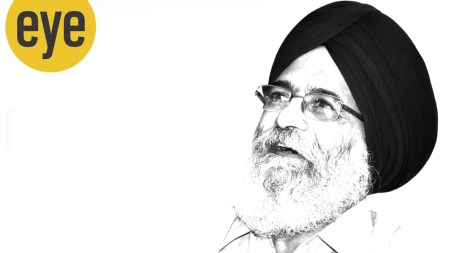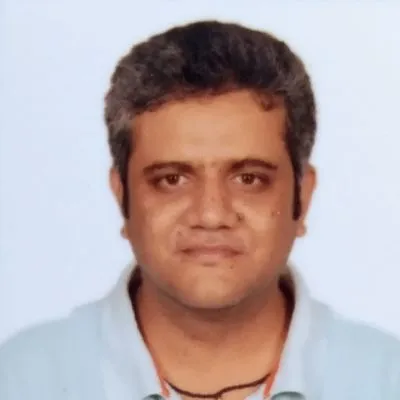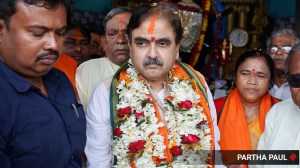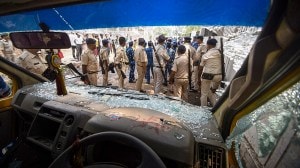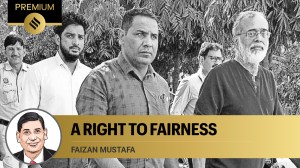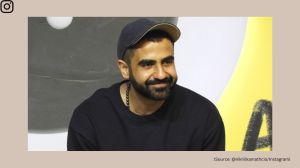- India
- International
Ram temple at Ayodhya: A 200-year journey, with many milestones
Here is a brief history of the Ram Janmabhoomi movement, which ended up changing the course of Indian politics.
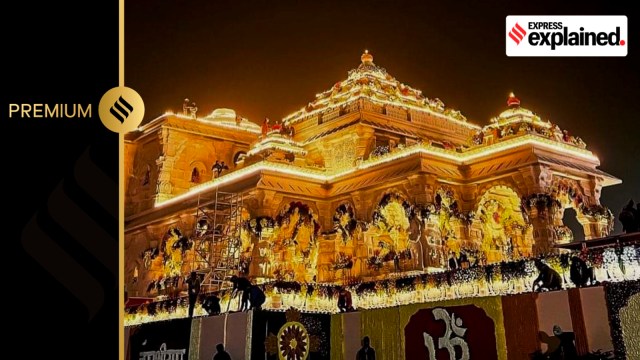 The Ayodhya Ram Temple is lit up ahead of its inauguration. (Photo: AP/File)
The Ayodhya Ram Temple is lit up ahead of its inauguration. (Photo: AP/File)The Ram Janmabhoomi movement for a grand temple at Ayodhya has a timeline running over more than two centuries, with several milestones amid the spilling of blood. Here is a brief history of the movement that ended up changing the course of Indian politics over the last three decades.
In 1751, the Marathas appealed to the Nawab of Awadh – whom they had helped defeat Pathan forces in the doab region – to transfer control of Ayodhya, Kashi and Mathura to them, says former BJP Rajya Sabha MP Balbir Punj in his recent book Tryst With Ayodhya. In 1756, too, when Nawab Shuja-ud-Daula sought their help against an imminent Afghan invasion, the Marathas requested that the three sites be transferred to them. However, the Nawab switched sides later, and the Maratha demand became irrelevant. They also lost the Third Battle of Panipat soon afterwards in 1761 to Ahmed Shah Abdali.
Punj says that in judicial records, the Ayodhya dispute dates back to 1822. A court official called Hafizullah made a submission to the Faizabad court in 1822 saying that a mosque built by Babur on the birthplace of Lord Ram, the son of Raja Dashrath, stood in close proximity to Sita Rasoi in Ayodhya.
On July 28, 1855, there was a bloody clash between Hindus and Muslims at Hanuman Garhi temple near the Babri Masjid. By the end of the day, Hindus – led by Naga Sadhus and Bairagis – killed 70-75 Muslims. Major General GD Outram had informed Nawab Wajid Ali Shah that one Shah Ghulam Hussein had gathered a large force to destroy the Hanuman Garhi, but the clash could not be averted. Fortified within Hanuman Garhi, the Hindus not only defended Hanuman Garhi but also captured Janmasthan (the place where Lord Ram was believed to have been born) from the Muslims on that blood-stained day, says the 2019 Supreme Court judgment on the Ayodhya title suit.
The judgment adds, “It is said that up to that time the Hindus and Muhammadans alike used to worship in the mosque-temple. Since British Rule, a railing has been put up to prevent the disputes, within which in the mosque the Muhammadans pray, while outside the fence the Hindus have raised a platform on which they make their offerings.”

In Hadiga-I-Shuhuda written by one Mirza Jan, the writer records an attack on the Ram Janmabhoomi by one Amir Ali Amethawi in 1856, but the attacker was killed by British troops.
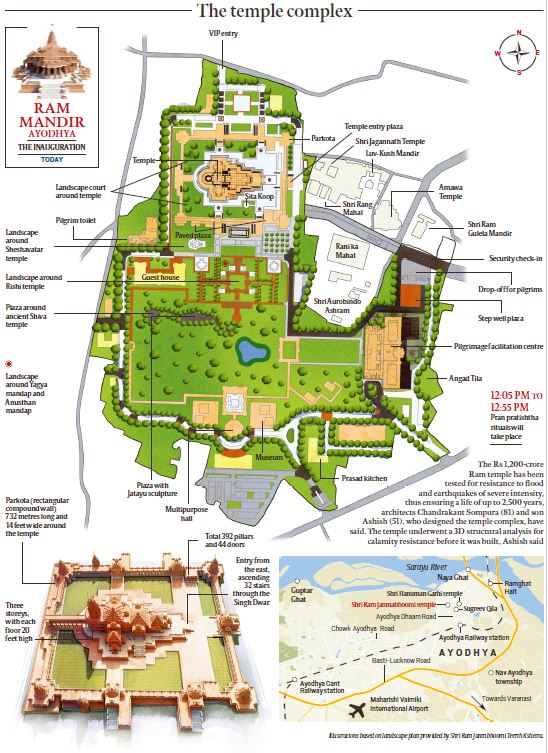
On November 30, 1858, an FIR was filed by a person called Mohammad Salim against Nihang Sikhs, who had installed the Nishan Sahib and performed a havana inside the Babri Masjid, also writing ‘Ram’ inside it.
On the same day, November 30, 1858, one Muhammad Asghar, the muadhhin of Babri Masjid, called for judicial proceedings against a Bairagi who had raised a platform in the courtyard. Asghar called for the dismantling of the platform.
In 1885, the mahant of Janmasthan Raghubar Das moved court to seek permission to build a Ram temple at the Ram Chabutra close to the Babri Masjid but within the complex. Historian Meenakshi Jain offers details about this case in her book Rama and Ayodhya. The petition was dismissed on the grounds that historical justice could not be delivered after so long a time and that there could be a law and order problem if the status quo was disturbed.
A petition was made to the UP government in July 1949 that a temple should come up at the site. The government forwarded it to the district administration of Faizabad for its comments and a report. City magistrate of Faizabad Guru Dutt Singh submitted a report in October, 1949, to the DM saying that the land belongs to the government and that people have faith in Ram Lalla and want a grand temple.
On August 14, 1949, the UP Hindu Mahasabha passed a resolution for the ‘liberation’ of Ram Janmabhoomi at Ayodhya, Krishna Janmabhoomi at Mathura and Vishwanath at Kashi. It cited the building of Somnath temple in Gujarat by the central government as the example to be followed.
From October 20, 1949, a nine-day akhand paath (continuous recitation) of the Ramacharitamanas was held in Ayodhya. Congress MLA from Faizabad Raghav Das attended the programme on the last day, sharing the stage with Mahant Digvijayanath of the Hindu Mahasabha – the guru of Mahant Avaidyanath, whose disciple Yogi Adityanath is now Chief Minister of UP – and Swami Karpatri of the Ram Rajya Parishad.
On the night of December 22-23, 1949, the idol of Ram Lalla was supposedly placed in the mosque by Abhiram Das, born Abhinandan Mishra before he became an ascetic (according to the Liberhan Commission). Supporters of the Ram temple claimed that the idol had appeared by itself, and the Muslim constable on duty Abdul Barkat claimed that he had fainted on seeing a light in the Masjid, in which appeared the figure of a “Godlike child” of about four or five years.
Then Prime Minister Jawaharlal Nehru directed the UP government to get the idol removed. However, City Magistrate Guru Dutt Singh, later hailed by VHP leader Ashok Singhal as the first Kar Sewak, did not allow Chief Minister Govind Ballabh Pant to enter Faizabad-Ayodhya and later submitted his resignation.
District Magistrate KK Nair also refused to remove the idol, citing law and order concerns. Faizabad Congress MLA Raghav Das threatened to resign if the idol was removed. The municipal board later acquired the site, with the idol inside. Nair was removed as DM, but his wife Shakuntala Nair won the 1952 Lok Sabha election from Gonda on a Hindu Mahasabha ticket. Guru Dutt Singh also later became the chairman of the municipality and also the district chief of the Jana Sangh.
Congress leader and former UP minister Dau Dayal Khanna was the first politician to write to then Prime Minister Indira Gandhi in May 1983 demanding the restoration of Ayodhya, Kashi and Mathura to the Hindus. Union minister Kamlapati Tripathi, a Congress veteran from UP, cautioned Khanna that he was playing with gunpowder and destroying the Congress policy of Hindu-Muslim unity.
On April 7 and 8, 1984, a meeting of the Dharma Sansad of the Vishwa Hindu Parishad, an RSS-affiliate, at the Vigyan Bhawan in Delhi, saw the organisation announcing the launch of a movement for the ‘liberation’ of Ram Janmabhoomi at Ayodhya, the Shri Krishna Janmabhoomi at Mathura and the Vishwanath shrine at Varanasi. Former interim Prime Minister Gulzarilal Nanda supported the Dharma Sansad, and Dau Dayal Khanna became the convenor of the Ram Janmabhoomi Mukti Yagna Samiti for the “liberation” of Ayodhya.
On July 1, 1984, the VHP at a meeting in Ayodhya decided to create public awareness about the temple agitation, says Punj in his book. This led to the Ram Janaki Yatra – which began on September 25, 1984, and ended on October 6 – from Sitamarhi in Bihar to Ayodhya.
In December, 1986, Faizabad district judge KM Pandey ordered the opening of the locks of the Babri Masjid and permitted Hindus to offer prayers therein. The judge later claimed in his book Voice of Conscience that a black monkey sat on the roof of the courtroom when the hearing was on. When he delivered the judgment and went home, he saw the “same monkey” in his lawn, and saluted him, “treating him to be some Divine Power”.
In mid-February, 1986, the All-India Muslim Personal Board met in Delhi and urged political parties to support their demand for the handing over of the Babri Masjid to Muslims.
On February 2, 1986, the VHP at a public meeting in Ayodhya demanded that the government set up a trust for the construction of a grand Ram temple at Ayodhya, Punj states.
On February 3, 1986, Hashim Ansari – one of the original litigants who had filed a writ petition on behalf of the Sunni Waqf Board on December 18, 1961 seeking possession of the Babri Masjid – moved the Allahabad High Court against the Faizabad district court’s order. The court said that until further orders by it, the nature of the property shall not change.
On February 6, 1986, the Babri Masjid Action Committee was formed at Lucknow.
On July 10, 1989, the Allahabad High Court decided to consolidate all suits related to the matter for adjudication. A Special Full Bench of Justices KV Agrawal, UC Srivastava and SHA Raza was constituted to look into the case.
From April 19 to 21, 1986, the VHP organised a Ram Janmabhoomi Mahotsav in Ayodhya, with large numbers of devotees taking a ritual dip in the Saryu, Punj writes.
An All-India Babri Masjid Conference was held under the leadership of Syed Shahabuddin on December 23-24, 1986, leading to the creation of Babri Masjid Movement Coordination Committee (BMMCC). The BMMCC organised a rally at Boat Club in Delhi on March 30, 1987.
In September, 1989, the VHP announced that it would take consecrated bricks from all over the country and perform a Shilanyas for a Ram temple at Ayodhya on October 10, 1989. The Congress government permitted it. Rajiv Gandhi launched his 1989 Lok Sabha campaign from Ayodhya.
The VHP organised a Sant Sammelan on February 1, 1989, in Ayodhya, in which it was decided to lay the foundation stone of a Ram temple at Ayodhya on November 10, 1989.
In July, 1989, the BJP took its first plunge into the movement, passing its Palampur resolution that said that Ram Janmabhoomi should be handed over to the Hindus through a negotiated settlement or legislation. The resolution said that courts could not adjudicate on Lord Ram.
On July 13, 1989, over 6000 volunteers from across India joined the movement during a Bajrang Dal convention in Ayodhya. Consecrated pitchers with water from the Saryu river were used in the ceremony, Punj writes.
On November 9, 1989, the foundation-laying ceremony was held, and Kameshwar Chaupal, a Dalit, laid the first Ram Shila.
On September 25, 1990, then BJP president LK Advani started the Rath Yatra from Somnath to Ayodhya. While there were no riots where the Yatra went, there were riots in many parts of India, killing about 600 people. Advani was arrested at Samastipur in Bihar on the orders of Chief Minister Lalu Prasad on October 23, 1990. The BJP withdrew support to the VP Singh government, which fell. There was police firing on Kar Sewaks in Ayodhya on October 30 and also November 2. Mulayam Singh Yadav was CM of UP at that time. Two brothers, Sharad and Ramkumar Kothari, who had come from Bikaner, were killed in police firing.
On December 6, 1992, a mob demolished the Babri Masjid. Advani, Joshi, Vijayaraje Scindia, Uma Bharti and Pramod Mahajan, were present on a podium erected atop a building nearby as the domes of the Masjid came down. The Kalyan Singh government in UP was dismissed, and Advani resigned as the Leader of the Opposition.
On January 7, 1993, Parliament passed the Acquisition of Certain Area at Ayodhya Act, which gave the government the authority to acquire 67.03 acres of the disputed Ram Janmabhoomi-Babri Masjid land. It also asked the Supreme Court via a presidential reference under Article 143 (1) of the Constitution to determine whether there was a pre-existing temple at the site before the Babri Masjid was built.
The Justice Liberhan Commission report was submitted on June 30, 2009. It said that the events of December 1992 were neither spontaneous nor unplanned. In April 2017, a special CBI court framed criminal charges against Advani, Joshi, Uma Bharti, Vinay Katiyar and others. On September 30, 2020, the court acquitted all 32 accused on grounds of inconclusive evidence, and the judge SK Yadav ruled that the demolition wasn’t pre-planned.
In 2010, a special bench of the Allahabad High Court under Justices SU Khan, Sudhir Agarwal and Dharam Veer Sharma in its Ayodhya title suit judgment divided the land in a 2:1 ratio, with two-thirds of the 2.77-acre, including the garbha griha, going to litigants for a Ram temple – Shri Ram Lala Virajman and Nirmohi Akhara. One-third of the land was given to the Sunni Central Waqf Board.
The verdict was challenged in the Supreme Court by both the Hindu and Muslim litigants. The apex court stayed the Allahabad High Court verdict. On November 9, 2019, a five-judge bench of the Supreme Court unanimously awarded the entire disputed land to the Hindu petitioners for a Ram temple at Ayodhya. It also decided to give land elsewhere for the construction of a mosque.
The Shri Ram Janmabhoomi Teerth Kshetra Trust was set up and the Shilanyas of the Ram temple was done by Prime Minister Narendra Modi on August 5, 2020, in Ayodhya. The temple will now be inaugurated on January 22.
More Explained
EXPRESS OPINION
May 17: Latest News
- 01
- 02
- 03
- 04
- 05


